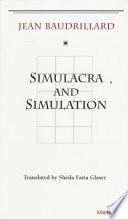“There is no aphrodisiac like innocence.”
Source: 1980s, Cool Memories (1987, trans. 1990), Chapter 5
Jean Baudrillard was a French sociologist, philosopher and cultural theorist. He is best known for his analyses of media, contemporary culture, and technological communication, as well as his formulation of concepts such as simulation and hyperreality. He wrote about diverse subjects, including consumerism, gender relations, economics, social history, art, Western foreign policy, and popular culture. Among his best known works are Simulacra and Simulation , America , and The Gulf War Did Not Take Place . His work is frequently associated with postmodernism and specifically post-structuralism. Wikipedia

“There is no aphrodisiac like innocence.”
Source: 1980s, Cool Memories (1987, trans. 1990), Chapter 5
“We live in a world where there is more and more information, and less and less meaning.”
Source: Simulacra and Simulation
"The Precession of Simulcra,MÖBIUS - SPIRALING NEGATIVETY
1980s, Simulacra and Simulation (1981)
New York (p. 15)
1980s, America (1986)
Context: Yet there is a certain solitude like no other - that of the man preparing his meal in public on a wall, or on the hood of his car, or along a fence, alone. You see that all the time here. It is the saddest sight in the world. Sadder than destitution, sadder than the beggar is the man who eats alone in public. Nothing more contradicts the laws of man or beast, for animals always do each other the honour of sharing or disputing each other’s food. He who eats alone is dead (but not he who drinks alone. Why is this?).
Jean Baudrillard in: Eldon Taylor What Does That Mean?: Exploring Mind, Meaning, and Mysteries http://books.google.co.in/books?id=pTAIRTJbENgC&pg=PA171, Hay House, Inc, 15 January 2010, p. 171
New millennium
The Precession of Simulcra, The Hyperreal and the Imaginary
1980s, Simulacra and Simulation (1981)
The Vital Illusion (2000) "The Murder of the Real". Wellek Library Lectures given May 1999 at the University of California, Irvine
New millennium
Source: 1980s, The Ecstasy of Communication (1987), p. 59
“The secret of theory is that truth does not exist.”
Source: Fragments: Cool Memories III, 1990-1995
Source: 1980s, The Ecstasy of Communication (1987), p. 73
Ecclesiastes
1980s, Simulacra and Simulation (1981)
The Precession of Simulcra
1980s, Simulacra and Simulation (1981)
“Forgetting extermination is part of extermination”
Holocaust
1980s, Simulacra and Simulation (1988)
Context: Forgetting extermination is part of extermination, because it is also the extermination of memory, of history, of the social, etc. This forgetting is as essential as the event in any case unlocatable by us, inaccessible to us itn its truth. This forgetting is still too dangerous, it must be effaced by an artificial memory (today, everywhere, it is artificial memories that effect the memory of man, that efface man in his own memory). This artificial memory will be the restaging of extermination - but late, much too late for it to be able to make real waves and profoundly disturb something, and especially, especially through medium that is itself cold, radiating forgetfulness, deterrence, and extermination in a still more systematic way, if that is possible, than the camps themselves.
“Nothing is wholly obvious without becoming enigmatic. Reality itself is too obvious to be true.”
1990s, The Perfect Crime (1993)
Source: Simulacra and Simulation
“One day, we shall stand up and our backsides will remain attached to our seats.”
1980s, Cool Memories (1987, trans. 1990)
The Precession of Simulcra
1980s, Simulacra and Simulation (1981)
New millennium, Photography, or the Writing of Light, (2000)
Source: 1980s, The Ecstasy of Communication (1987), p. 65
Canadian Journal of Political and Social Theory 15 (1987) "When Bataille Attacked the Metaphysical Principle of Economy"
1980s
Vanishing Point (pp. 9-10)
1980s, America (1986)
“When the real is no longer what it was, nostalgia assumes its full meaning.”
The Precession of Simulcra, The Divine Irreference Of Images
1980s, Simulacra and Simulation (1981)
“Distinctive signs, full signs, never seduce us.”
Source: 1980s, The Ecstasy of Communication (1987), p. 59
New millennium
"The Precession of Simulcra,MÖBIUS - SPIRALING NEGATIVETY
1980s, Simulacra and Simulation (1981)
Source: 1980s, The Ecstasy of Communication (1987), p. 42
Source: 1980s, The Ecstasy of Communication (1987), p. 43
The Spirit of Terrorism (2003) "The Violence of the Global"
New millennium
1980s, Simulacra and Simulation (1981)
1980s, Simulacra and Simulation (1981)
Source: 1980s, The Ecstasy of Communication (1987), p. 30
1990s, Radical Thought (1994)
Source: 1980s, The Ecstasy of Communication (1987), p. 67
Source: 1980s, Simulacra and Simulation (1988), Ch. 18 : On Nihilism, translation by Sheila Faria Glaser.
The Illusion of the End (1992) (L'Illision de la Fin) Tr. Chris Turner, 1994, Stanford University Press, ISBN 0804725012, p. 26, "The Event Strike"
1990s
“A series of accidents creates a positively lighthearted state.”
Source: 1980s, Cool Memories (1987, trans. 1990), Chapter 4
“Challenge, and not desire, lies at the heart of seduction.”
Source: 1980s, The Ecstasy of Communication (1987), p. 57
“The real is not only what can be reproduced, but that which is already reproduced, the hyper-real.”
Simulations (1983), New York: Semiotext, p. 146
1980s
New millennium, Photography, or the Writing of Light, (2000)
Source: 1980s, Cool Memories (1987, trans. 1990), Chapter 1
The Precession of Simulcra, Ramses, or the Rosy-Colored Resurrection
1980s, Simulacra and Simulation (1981)
New millennium, Photography, or the Writing of Light, (2000)
The Precession of Simulcra
1980s, Simulacra and Simulation (1981)
1980s, Cool Memories (1987, trans. 1990)
Source: 1980s, Cool Memories (1987, trans. 1990), Chapter 3
New millennium
The Precession of Simulcra, The Hyperreal and the Imaginary
1980s, Simulacra and Simulation (1981)
The Precession of Simulcra, The Divine Irreference Of Images
1980s, Simulacra and Simulation (1981)
Source: 1980s, The Ecstasy of Communication (1987), p. 65
